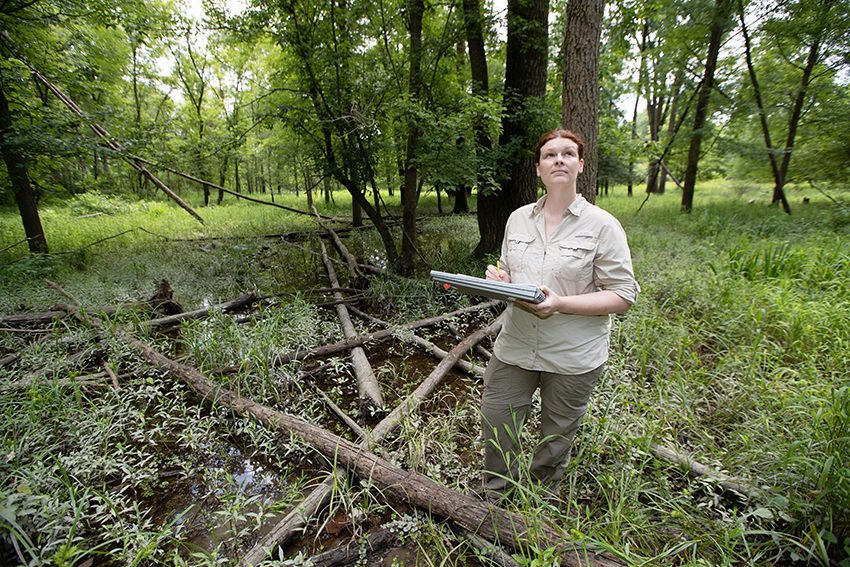Fighting back against the emerald ash borer

By Amber Stark '99
The public health, social, environmental and economic benefits of trees are well known – and continue to expand with current trends like forest bathing. But since 2003, a little green beetle has been threatening trees in Ohio and beyond.
The emerald ash borer, an invasive, exotic beetle discovered in southeastern Michigan in 2002, has killed hundreds of millions of ash trees in North America. In Ohio, where at one time one in every 10 trees was an ash tree, the ½-inch long bug seemed to have won its war.
But Bowling Green State University postdoctoral researcher Dr. Rachel Kappler says all may not be lost.
“The future will be variable,” she said. “So we have to just keep ourselves aware and informed and expect that, by the time the next tree generation turns from youth to adult, management methods may prove to be beneficial. I want the public to keep hope that we’ll be able to keep ash trees around.”
In July, Kappler received the 2019 Graduate College Distinguished Dissertation Award with her dissertation, “Exploring the Population Viability of Green Ash (Fraxinus pennsylvanica) with a Stage Based Model.”
“I am really honored that they chose me for that,” she said. “It was a good surprise.”
“Rachel’s project was novel in combining very sophisticated modeling tools with field surveys and experiments to examine forest recovery from the impacts of the invasion of emerald ash borer,” said Dr. Karen Root, associate professor of conservation biology, on why the biology department nominated Kappler for the award. “Her dissertation is a great example of how ecological research can be applied effectively to address environmental issues.”
Kappler’s research into emerald ash borers started when she was a summer research technician as part of a collaboration with the U.S. Forest Service and the Toledo Metroparks. Her experience gathering data on ash tree populations and researching pest-management actions inspired her Ph.D. dissertation with Root.
“The overall goal was to understand the ash trees’ population demographics and their possible future persistence in natural areas,” Kappler said.
Her current postdoctoral research expands on her dissertation research by reassessing ash research plots across all of Ohio to understand the impact of the invasive beetles, to test which land management actions work the best, and, hopefully, find individual ash trees that have survived the invasion. Trees that have survived may be tested by the Forest Service for their potential tolerance or resistance to the invasive beetle.
Kappler, a Michigan native, chose BGSU for her graduate research partially because of the research the biology department was conducting.
“I also really clicked with Dr. Root and the research she was doing,” she said. “She is very open to our project ideas; she’s very collaborative.”
Root is currently serving a six-year leadership role with the Society for Conservation Biology North America, a global community of conservation professionals. The term includes two years as president-elect, two years as president and two years as past-president.
Kappler has spent three summers researching ash trees, vegetation around where they live and emerald ash borers. Besides fulfilling her desire for research, the experience has helped her brush up on her botany skills.
“I was surprised when I first started out at how it was an invasive beetle taking out a plant,” she said. “I was also surprised at how prevalent the ash tree was in certain locations. It is one of the main trees found in areas along creeks and ditches and areas that flooded. I didn’t really realize that before.”
Although ash trees and the emerald ash borer infestation hadn’t been on her radar, Kappler immediately got up to speed, tracking individual adult ash trees and thinking about young ash trees.
“Population ecology is something I am interested in,” she said. “I took a more in-depth look at where seedlings were growing and, using a population model, carried the current situation forward, looking at survival and how well they would do based on size.”
This allowed her to hypothesize about how emerald ash borers may continue to impact ash tree populations and whether different pest-management methods, such as introducing a wasp to eat emerald ash borer larva, could have a positive impact.
“Main population predications were the bulk of my dissertation,” Kappler said. “I looked at several possibilities — what would happen under scenario A, or what could happen in scenario B. This gave me ideas for moving forward, which we can test against what really happens to see if the predictive model was accurate or not.”
While Kappler is hopeful about the future of ash trees, she is concerned that her efforts to germinate ash trees isn’t going very well.
Kappler will use the next year to tie all of her projects together. After that, she would like to focus on population ecology.
“As you grow up, you realize there are major issues occurring within the natural environment,” she said. “Being able to conserve species is important because if we have more species around when major environmental changes occur, it’s more likely that the whole environment in and of itself will survive and thrive even though they go through tough changes.
“This not only helps our natural areas, but we also benefit from having those natural areas running properly. It gives me purpose in my work to see how these populations are working and how we can make sure we have a number of different species coexisting in order to get the biggest amount of resilience when an environmental issue occurs, like the emerald ash borer.”
Updated: 12/11/2019 03:52PM
